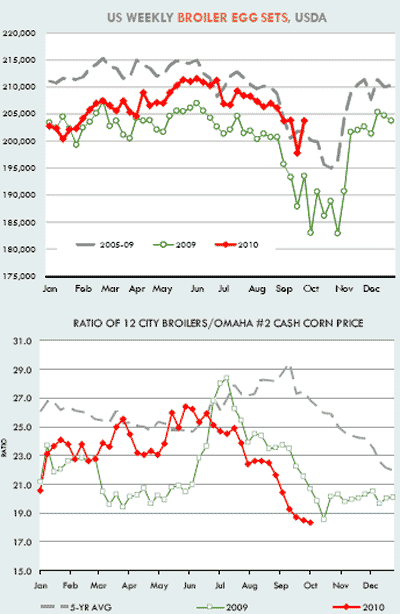



CME: Future Adjustments Likely for Broiler Output
US - Broiler supplies have been trending higher in recent months and the expectation is for broiler production in 2011 to continue to increase from current levels, write Steve Meyer and Len Steiner.The latest USDA report indicated that broiler output in 2010 is expected to be 35.991 billion pounds, 860 million pounds or 2.4 per cent higher than in 2009. For next year, broiler production is forecast to hit 36.926 billion pounds, almost a billion pounds or 2.6 per cent higher than in 2010.
Broiler meat is the largest meat protein in the market and changes in output have an impact not just on broiler prices but the overall meat complex.
The big question for broiler producers, however, is the outlook for profitability in light of higher corn prices not just in the short term (for which they may have some hedges) but for 2011 and beyond. It is likely that large producers already may have hedged a good portion of their feed supplies for the fall, and so far egg sets have tracked well above year ago levels.
For the week ending 25 September, broiler producers in the 19 reference states set 203,706 eggs in incubators, 5.3 per cent more than the comparable week a year ago. In the last six weeks, egg sets have been on average 4.3 per cent higher than a year ago, indicating strong production growth into the end of the year. Seasonally, egg sets decline into the fall but overall current egg set and chick placement activity has been relatively strong. That may not last for too long.
In the bottom chart, we show the ratio of current broiler prices to the price of cash corn. Again, different producers face different feed costs given their ability to lock in prices earlier in the year. However, the broiler/corn ratio is still a good indicator of the long term profitability in the industry and it signals the need for future adjustments in order to maintain margins. At this time, the ratio of the 12 city broiler price to #2 Omaha corn is at the lowest point for the year and also lower than year ago levels. And while corn futures may have taken a step back recently, they still remain above the $5 mark for next summer.
The hedging opportunities today are a lot worse than they were last spring and hoping for lower prices may not be a good strategy given the current volatile market. Our sense is that while USDA may expect production for next year to grow a decent 2.6 per cent, in order for that to happen end users, both retailers and food-service operators will have to pay much higher prices than 2010 levels.
Also important will be the recovery of broiler export markets lost in 2010. Shipments to Russia remain very slow and the industry has not been able to put more money on leg quarters. Broiler breast meat prices have declined sharply since Labor Day, which seasonally is not that unusual. Any further declines in breast meat values, however, will make it even more difficult for producers to maintain current growth projections.












